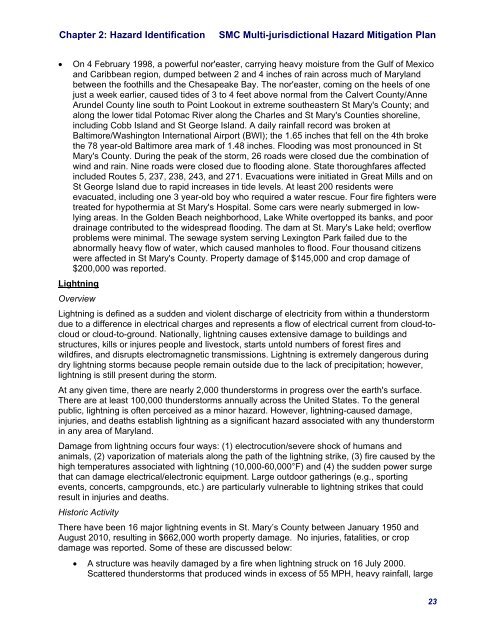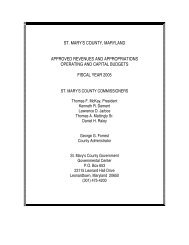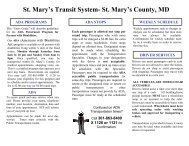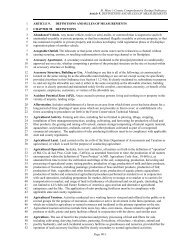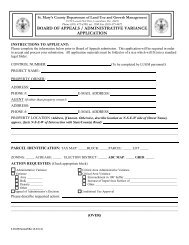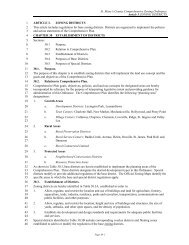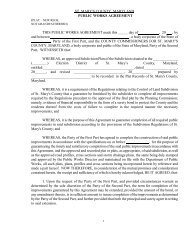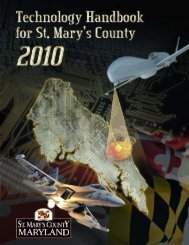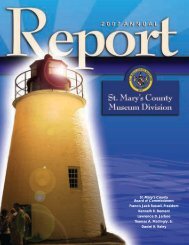St. Mary's County Multi-Jurisdictional Hazard Mitigation Plan
St. Mary's County Multi-Jurisdictional Hazard Mitigation Plan
St. Mary's County Multi-Jurisdictional Hazard Mitigation Plan
Create successful ePaper yourself
Turn your PDF publications into a flip-book with our unique Google optimized e-Paper software.
Chapter 2: <strong>Hazard</strong> Identification<br />
SMC <strong>Multi</strong>-jurisdictional <strong>Hazard</strong> <strong>Mitigation</strong> <strong>Plan</strong><br />
• On 4 February 1998, a powerful nor'easter, carrying heavy moisture from the Gulf of Mexico<br />
and Caribbean region, dumped between 2 and 4 inches of rain across much of Maryland<br />
between the foothills and the Chesapeake Bay. The nor'easter, coming on the heels of one<br />
just a week earlier, caused tides of 3 to 4 feet above normal from the Calvert <strong>County</strong>/Anne<br />
Arundel <strong>County</strong> line south to Point Lookout in extreme southeastern <strong>St</strong> <strong>Mary's</strong> <strong>County</strong>; and<br />
along the lower tidal Potomac River along the Charles and <strong>St</strong> <strong>Mary's</strong> Counties shoreline,<br />
including Cobb Island and <strong>St</strong> George Island. A daily rainfall record was broken at<br />
Baltimore/Washington International Airport (BWI); the 1.65 inches that fell on the 4th broke<br />
the 78 year-old Baltimore area mark of 1.48 inches. Flooding was most pronounced in <strong>St</strong><br />
<strong>Mary's</strong> <strong>County</strong>. During the peak of the storm, 26 roads were closed due the combination of<br />
wind and rain. Nine roads were closed due to flooding alone. <strong>St</strong>ate thoroughfares affected<br />
included Routes 5, 237, 238, 243, and 271. Evacuations were initiated in Great Mills and on<br />
<strong>St</strong> George Island due to rapid increases in tide levels. At least 200 residents were<br />
evacuated, including one 3 year-old boy who required a water rescue. Four fire fighters were<br />
treated for hypothermia at <strong>St</strong> <strong>Mary's</strong> Hospital. Some cars were nearly submerged in lowlying<br />
areas. In the Golden Beach neighborhood, Lake White overtopped its banks, and poor<br />
drainage contributed to the widespread flooding. The dam at <strong>St</strong>. <strong>Mary's</strong> Lake held; overflow<br />
problems were minimal. The sewage system serving Lexington Park failed due to the<br />
abnormally heavy flow of water, which caused manholes to flood. Four thousand citizens<br />
were affected in <strong>St</strong> <strong>Mary's</strong> <strong>County</strong>. Property damage of $145,000 and crop damage of<br />
$200,000 was reported.<br />
Lightning<br />
Overview<br />
Lightning is defined as a sudden and violent discharge of electricity from within a thunderstorm<br />
due to a difference in electrical charges and represents a flow of electrical current from cloud-tocloud<br />
or cloud-to-ground. Nationally, lightning causes extensive damage to buildings and<br />
structures, kills or injures people and livestock, starts untold numbers of forest fires and<br />
wildfires, and disrupts electromagnetic transmissions. Lightning is extremely dangerous during<br />
dry lightning storms because people remain outside due to the lack of precipitation; however,<br />
lightning is still present during the storm.<br />
At any given time, there are nearly 2,000 thunderstorms in progress over the earth's surface.<br />
There are at least 100,000 thunderstorms annually across the United <strong>St</strong>ates. To the general<br />
public, lightning is often perceived as a minor hazard. However, lightning-caused damage,<br />
injuries, and deaths establish lightning as a significant hazard associated with any thunderstorm<br />
in any area of Maryland.<br />
Damage from lightning occurs four ways: (1) electrocution/severe shock of humans and<br />
animals, (2) vaporization of materials along the path of the lightning strike, (3) fire caused by the<br />
high temperatures associated with lightning (10,000-60,000°F) and (4) the sudden power surge<br />
that can damage electrical/electronic equipment. Large outdoor gatherings (e.g., sporting<br />
events, concerts, campgrounds, etc.) are particularly vulnerable to lightning strikes that could<br />
result in injuries and deaths.<br />
Historic Activity<br />
There have been 16 major lightning events in <strong>St</strong>. Mary’s <strong>County</strong> between January 1950 and<br />
August 2010, resulting in $662,000 worth property damage. No injuries, fatalities, or crop<br />
damage was reported. Some of these are discussed below:<br />
• A structure was heavily damaged by a fire when lightning struck on 16 July 2000.<br />
Scattered thunderstorms that produced winds in excess of 55 MPH, heavy rainfall, large<br />
23


